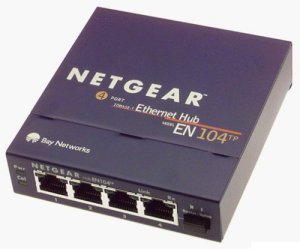Hubs/repeaters are used to connect together two or more network segments of any media type. In larger designs, signal quality begins to deteriorate as segments exceed their maximum length. Hubs provide the signal amplification required to allow a segment to be extended a greater distance. Passive hubs simply forward any data packets they receive over one port from one workstation to all their remaining ports. Active hubs, also sometimes referred to as multiport repeaters, regenerate the data bits in order to maintain a strong signal.
Hubs are also used in star topologies such as 10BaseT. A multi-port twisted pair hub allows several point-to-point segments to be joined into one network. One end of the point-to-point link is attached to the hub and the other is attached to the computer. If the hub is attached to a backbone, then all computers at the end of the twisted pair segments can communicate with all the hosts on the backbone.

An important fact to note about hubs is that they only allow users to share Ethernet. A network of hubs/repeaters is termed a shared Ethernet, meaning that all members of the network are contending for transmission of data onto a single network (collision domain). This means that individual members of a shared network will only get a percentage of the available network bandwidth. The number and type of hubs in any one collision domain for 10BaseT Ethernet is limited by the following rules:
| Network Type | Max Nodes Per Segment | Max Distance Per Segment |
|---|---|---|
| 10BaseT | 2 | 100m |
| 10Base2 | 30 | 185m |
| 10Base5 | 100 | 500m |
| 10BaseFL | 2 | 2000m |
While repeaters allow LANs to extend beyond normal distance limitations, they still limit the number of nodes that can be supported. Bridges, routers and switches, however, allow LANs to grow significantly larger by virtue of their ability to support full Ethernet segments on each port.